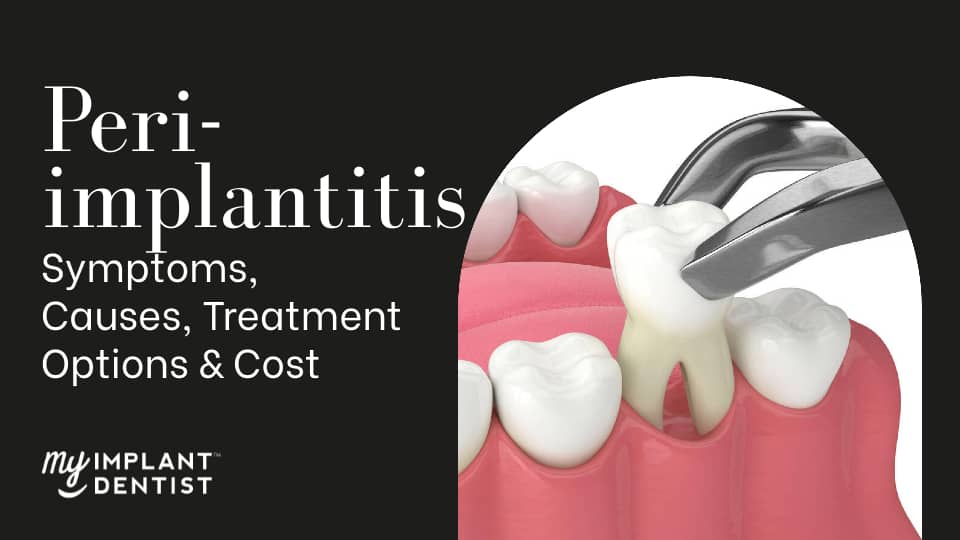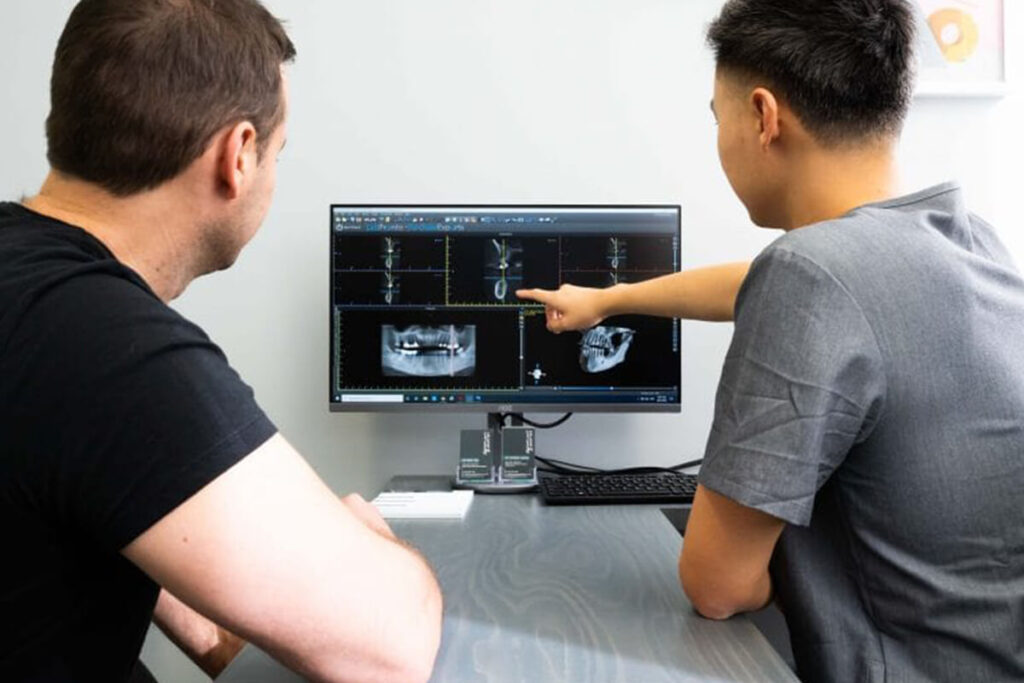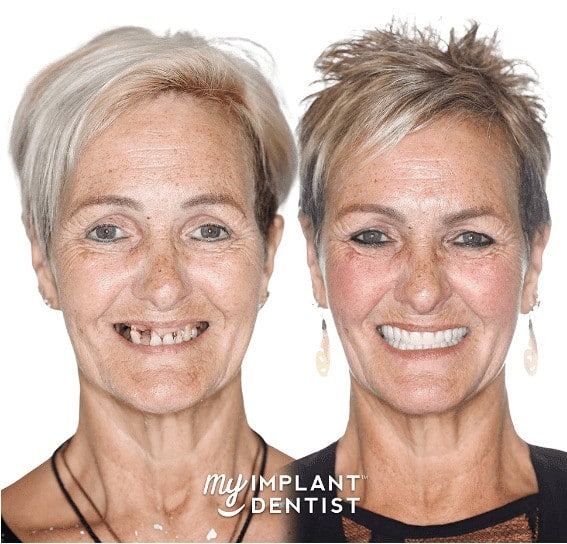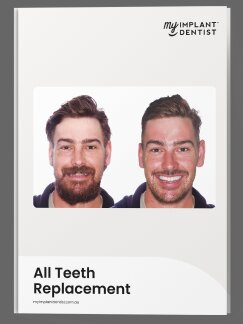
Contents
Key Takeaways:
- Pathological conditions that surround dental implants are known as peri-implantitis.
- Swollen gums and continuous bleeding are common symptoms of peri-implantitis.
- Early detection of peri-implantitis symptoms may help stop the need for surgical treatment.
Dental implants are great for replacing missing or damaged teeth. There are also problems or health challenges associated with dental implants.
The most common dental health problem associated with dental implants is Peri-implantitis. When left untreated for a long time, peri-implantitis can erode the bone structure supporting the implants. At this stage, major surgery is the key to oral health restoration.
This article will teach you what you need to know about peri-implantitis, its symptoms, causes, and treatment options. Keep reading!
What Is Peri-implantitis?
Peri-implantitis is an inflammatory condition affecting the oral tissues. If you have a dental implant, you risk this disease. Peri-implantitis causes soft tissue inflammation and a gradual reduction and destruction of the bone surrounding the dental implant.
The peri-implant disease occurs in two stages – peri-implant mucositis and peri-implantitis.
The peri-implant mucositis is the earliest stage of peri-implant disease. It does not affect the supporting bone, but the soft tissues surrounding the dental implants get concerned. Peri-mucositis, when not treated, progresses into peri-implantitis.
At the peri-implantitis stage, the supporting one becomes affected alongside the soft tissues surrounding the dental implants. When this goes untreated for a long time, the dental implant fails due to loss of bone.
Therefore, close attention is paid to implants to determine which peri-implant stage disease is onto it.
Causes of Peri-implantitis
There is a chance that peri-implantitis will occur in all individuals with dental implants. Bacteria play a significant role in the cause of peri-implantitis though it is not the main cause.
An implant can never be attached to the gum as natural teeth would. This implies that there exists little space between the implant and the gum.
So, the gum around the implant is loose.
The loose nature of the gum around the implant causes bacteria to amass and inflame the surrounding tissue. This inflammation leads to peri-implantitis, which results in bone loss.
However, some of the causing factors that increase your risk of developing peri-implantitis include:
- An earlier diagnosis of periodontal disease.
- Improper oral hygiene
- Bruxism (grinding of your teeth)
- Tobacco use or heavy smoking
- An improperly placed dental implant
Peri-implantitis Symptoms
There is no doubt that the symptoms of peri-implantitis are similar to that of gum disease. Detecting symptoms early would save you the stress of having surgical treatment later.
Some of the common signs and symptoms of peri-implantitis include:
- Bleeding in the mouth
- A loose implant and slight movement of the dental implant
- Swollen gums and lymph nodes
- Difficulty in chewing
- Bad breath
- Edema (puffiness caused by excess fluid trapped in the body’s tissue).
- Pus in the mouth
- Pain or fever
- Redness and swelling of the soft tissue
- Tender gums
Diagnosis of Peri-implantitis Syndrome
Your dentist can diagnose peri-implantitis syndrome during a clinical examination. The dentist will take radiographs of your mouth.
There will also be checking periodontal probing depths, bleeding on probing (BOP), exudate, mobility, and occlusion. Your dentist may also check the bacteria profile of the area surrounding the implant to confirm the disease progression.
During probing, your periodontist will use a probe to measure the depths of your pockets. There is an indication of peri-implant disease when the pockets are deeper than 4mm.
For your peri-implantitis, your dentist takes a baseline radiograph. If your radiograph indicates 2mm of bone loss or more, it strongly shows peri-implantitis.
Treatment of Peri-implantitis
There are many treatment options out there for you if you have peri-implantitis. However, the severity of your condition determines the option your dentist recommends.
In most cases, your dentist may choose to combine several treatments to get you what you need.
Some of the available treatment options include:
1. Mechanical Debridement
Mechanical debridement is the professional removal of plaque and tartar. It is an ineffective and inefficient means of treating peri-implantitis because it doesn’t remove all the bacteria.
Mechanical debridement is often merged with antiseptic, antibiotics, and surgical procedures. To remove calculus, your dentist will use Ultrasonic Scalers with carbon/resin fibre curettes or a non-metallic tip.
2. Antiseptic
Your dentist may choose to use antiseptic treatment alongside mechanical debridement. They will give you a daily rinse that should last three to four weeks.
The sole aim of the daily rinse is to improve the mucosal condition, probing pocket depth, and clinical attachment level. Teeth staining is a side effect of the antiseptic treatment.
3. Antibiotic Treatment
Your dental care provider will provide you with an antibiotic treatment to eliminate the pathogens in the biofilm. An antibiotic that targets gram-negative anaerobic bacteria is administered to ensure the infection is addressed during the final ten days of treatment.
Your dental care provider can also treat your peri-implantitis using surgical treatment. Surgical treatment is best when the infection seems under control. During the process, the tooth implant infection treatment can remodel the soft tissue surrounding the implant and repair missing bone.

Peri-implantitis Treatment Cost
The cost of peri-implantitis treatment depends on how many treatments your dental care provider deems fit. The most expensive treatment is the Laser Peri-Implantitis Treatment (LAPIP). LAPIP involves the use of laser treatment to help the infected dental implants.
The Laser Peri-implantitis Treatment costs about $3000. The cost is cheaper than replacing the entire dental implant.
It is best to discuss with your dentist the treatment option suitable for you and the cost.
Risk Factors
Various risk factors lead to a higher chance of having peri-implantitis disease. Some of the high-risk factors include :
- Lack of maintenance
- Diabetes
- Periodontitis (a gum disease that damages the gum and destroys your jawbone)
- Improper brushing and flossing
- Systematic diseases such as cardiovascular disease and rheumatoid arthritis.
- Genetics factor.
faqs
How Common Is Peri-implantitis?
Peri-implantitis is the most common oral health problem that probe people with dental implants. About 28 per cent of people with dental implants develop this oral health issue.
Is Peri-implantitis An Emergency?
Yes, peri-implantitis is an emergency because it destroys the gums and surrounding tissues around the implant once it gets worse. So, it is better to detect early and treatment commenced on time.
Can Peri-implantitis Go Away On Its Own?
Peri-implantitis cannot go away on its own. The disease is not curable; it can only be managed.
Can Peri-implantitis Be Cured?
No, it can’t be cured. Peri-implantitis can only be managed and controlled through antiseptics, antibiotics, and surgical treatments.
Is Peri-implantitis Painful?
There could be mild pain when chewing and a slight sensitivity felt around the areas surrounding the dental implants.
Conclusion
After your dental care provider has successfully treated your peri-implantitis disease, you may still be at high risk of developing the disease again. Your best option is to reduce your risk of developing the disease.
The first step is to develop good oral hygiene habits and clean the areas surrounding the dental implants with utmost care and precaution. Brushing and flossing twice a day, alongside avoiding smoking, will also go a long way to reducing your risk of developing the disease.
You must also maintain your regular visit to your dental care provider. Regular periodontal examinations are necessary to evaluate your oral health and determine the state of your dental implants.
Ensure you visit a professional dental clinic like My Implant Dentist to ensure your implants are healthy. Our top dental are always ready to assist you.




















